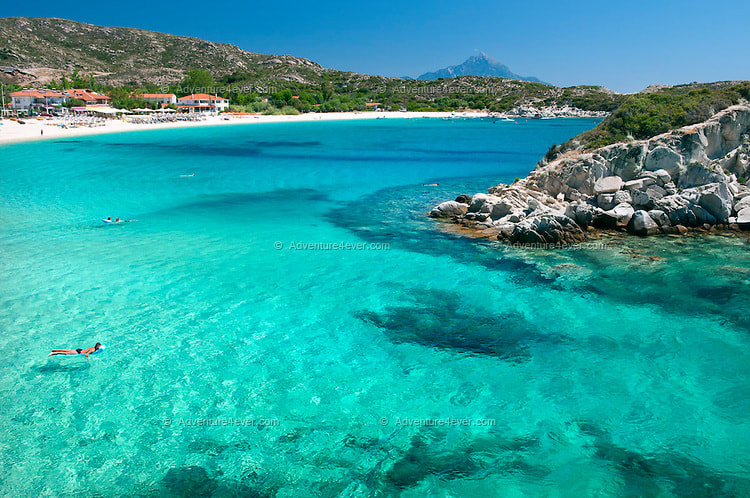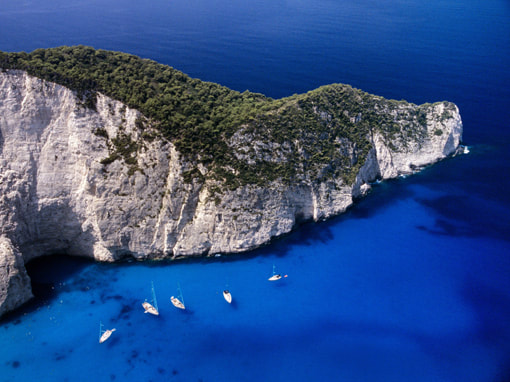Chalkidiki
|
Shaped like Poseidon’s trident and sticking out into the Aegean Sea, Halkidiki is a treat for visitors. Lush green forests that reach right down to the beach; golden sunlight reflected in the turquoise waters; a traditional style with a rich gastronomic and cultural heritage. Endless coves, unique architectural sites, perfectly preserved Christian monument and a host of unexplored treasures all add their own rich touch to the unique canvas that is Halkidiki.
|
Halkidiki is also home to many earthly paradises for those who love mountains. Paths for mountain biking and walking cut their way through the forests of pine, oak, fir and chestnut trees. Here you can feel the pure air refreshing every cell in your body, and crystal clear refreshingly cool water gushes from dozens of hidden springs for you to quench your thirst. If you’d like to stay in the mountains, check out the traditional guesthouses at Holomóntas and in other areas up on the mountain slopes.
Of course, anyone who wants to truly feel the vastness of the Aegean and O.D. on adrenaline at the same time needs to devote a little time to some serious sea sports! Windsurfing, kitesurfing, diving, water skiing and many other sea sports activities are all on offer for you here – and the facilities in Kassándra and Sithonia are excellent. Every July a major swimming event takes place here at Toronéos, one of the world’s largest events at 26 km. The competition attracts swimmers from all over the world.
Also, during summer, a lot of remarkable artistic festivals take place in many parts of Halkidiki. Music provides the main focus, but the performing arts are also prominent, and every summer the region’s open-air theatres play host to some major presentations.
Content source: http://www.visitgreece.gr
Grekolidays.com has been founded in 2017, in order to serve the best services for you to find the most suitable places for short or long stay vacations. At this website you will find various options for villas, studios, rooms and apartments in the whole region of Chalkidiki and Zakynthos.
Zakynthos
Zákynthos (Zante) is the flower of the East.
Zákynthos (Zante) is a verdant island endowed with fertile valleys and a temperate climate (area: 406 sq. km; coastline: 123 km). Its landscape diversity has resulted in different types of beaches: there are sandy beaches in secluded coves where the tranquil waters are deep blue on the island’s southeastern part; yet, if rugged cliffs and an interesting underwater worldare to your liking, try the western part of the island.
The Venetians, who ruled Zákynthos from 1484 to 1797, called the island “Fioro di Levante” (flower of the East) as there are over 7,000 species of flowers on Zákynthos. The third largest island of the Ionian Sea, after Corfu and Kefaloniá, is internationally known as “Zante”. Zákynthos is said to have been the island’s first inhabitant and the ancient acropolis is attributed to him. He was the son of Dardanos who ruled the ancient kingdom of Frigia. A Venetian fort was built at later times on the site.
The Venetian architectural influence has left its stamp on Zante despite the damage sustained due to the seismic activity in the area. After the ravaging 1953 earthquake and the ensuing fire, a number of historical buildings and churches burned to the ground. Consequently, the significant treasures these buildings were housing perished. The town was rebuilt according to a plan where strict anti-seismic specifications applied and, to a large extent, respecting the town’s former architectural structure.
On Zante, great care is taken to protect two endangered animal species, namely the caretta aretta sea turtle and the monachus monachus seal.
The city of Zakynthos is the capital of the island and at the same time the island's port.
Content source: http://www.visitgreece.gr
Zákynthos (Zante) is a verdant island endowed with fertile valleys and a temperate climate (area: 406 sq. km; coastline: 123 km). Its landscape diversity has resulted in different types of beaches: there are sandy beaches in secluded coves where the tranquil waters are deep blue on the island’s southeastern part; yet, if rugged cliffs and an interesting underwater worldare to your liking, try the western part of the island.
The Venetians, who ruled Zákynthos from 1484 to 1797, called the island “Fioro di Levante” (flower of the East) as there are over 7,000 species of flowers on Zákynthos. The third largest island of the Ionian Sea, after Corfu and Kefaloniá, is internationally known as “Zante”. Zákynthos is said to have been the island’s first inhabitant and the ancient acropolis is attributed to him. He was the son of Dardanos who ruled the ancient kingdom of Frigia. A Venetian fort was built at later times on the site.
The Venetian architectural influence has left its stamp on Zante despite the damage sustained due to the seismic activity in the area. After the ravaging 1953 earthquake and the ensuing fire, a number of historical buildings and churches burned to the ground. Consequently, the significant treasures these buildings were housing perished. The town was rebuilt according to a plan where strict anti-seismic specifications applied and, to a large extent, respecting the town’s former architectural structure.
On Zante, great care is taken to protect two endangered animal species, namely the caretta aretta sea turtle and the monachus monachus seal.
The city of Zakynthos is the capital of the island and at the same time the island's port.
Content source: http://www.visitgreece.gr
Grekolidays.com has been founded in 2017, in order to serve the best services for you to find the most suitable places for short or long stay vacations. At this website you will find various options for villas, studios, rooms and apartments in the whole region of Chalkidiki and Zakynthos.





